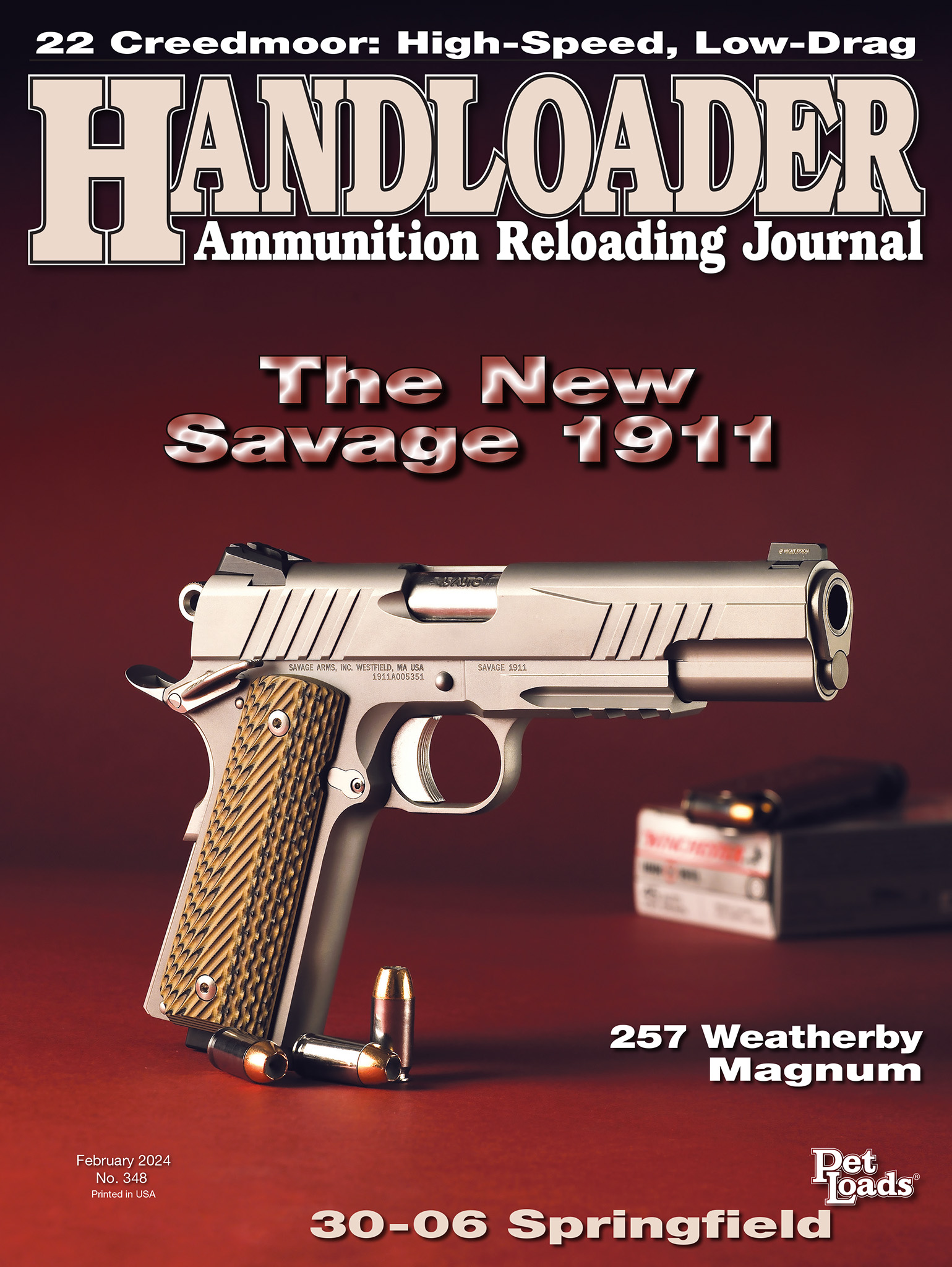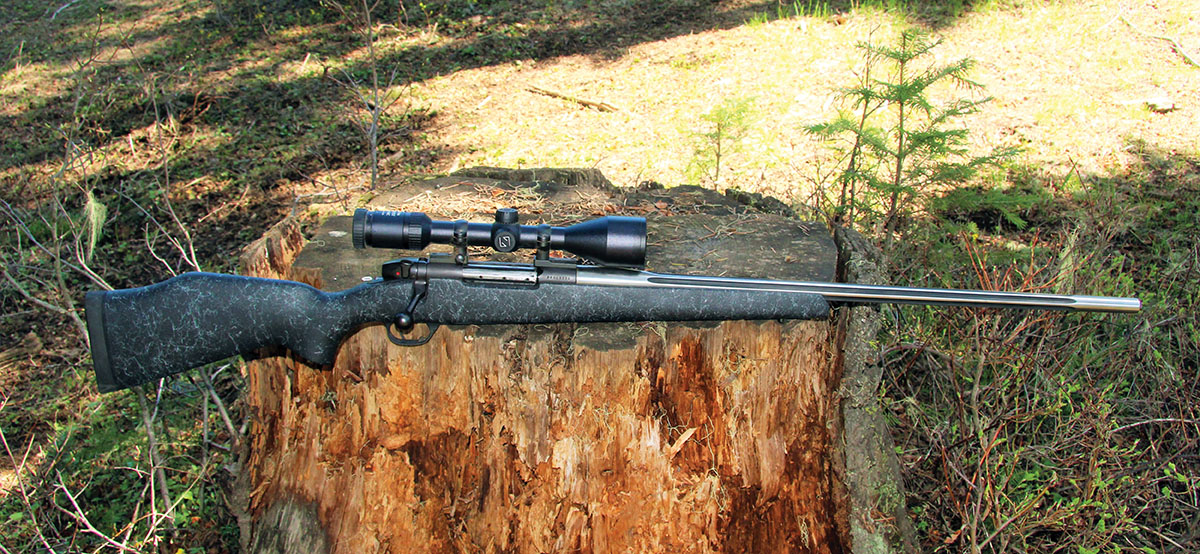
The Weatherby Mark V test rifle is considered one of the company’s top models. When shooting modern long-range bullets, the rifle is unfortunately hobbled by its traditional 1:10 rifling twist.
Kelsey Denton and I have been hunting, fishing and kicking around together since seventh grade. Kelsey was the best man at my wedding and we still take time out of insanely hectic schedules to occasionally hunt, fish and hang out as graying middle-aged men. With a big brain that understands advanced mathematics, Kelsey became a chemical engineer and has lived “The American Dream,” including having the wherewithal to purchase a gorgeous piece of ground in central Colorado with a trout creek running through it and prime habitat teaming with mule deer and elk. It is the latter that ultimately inspired this project.
On many occasions, Kelsey and I had discussed using his 257 Weatherby Magnum for the big game that lurk on his property. With his recent retirement, that need became more relevant. Kelsey chose the 257 Weatherby Magnum cartridge years ago while preparing for a New Mexico pronghorn hunt where I served as guide. He had used my custom 25-06 Remington the previous year to tag a Boone and Crockett buck, yet he yearned for something even flatter shooting. The 257 Weatherby Magnum is certainly that, gaining 150 to 200 feet per second (fps) on the older 25-06. The problem was Kelsey’s rifle had proven pretty finicky. This is likely a result of Weatherby’s long throat (.378 inch), introduced to control chamber pressure, the round’s bullet-taxing velocity and his rifle’s traditional 1:10 rifling twist.
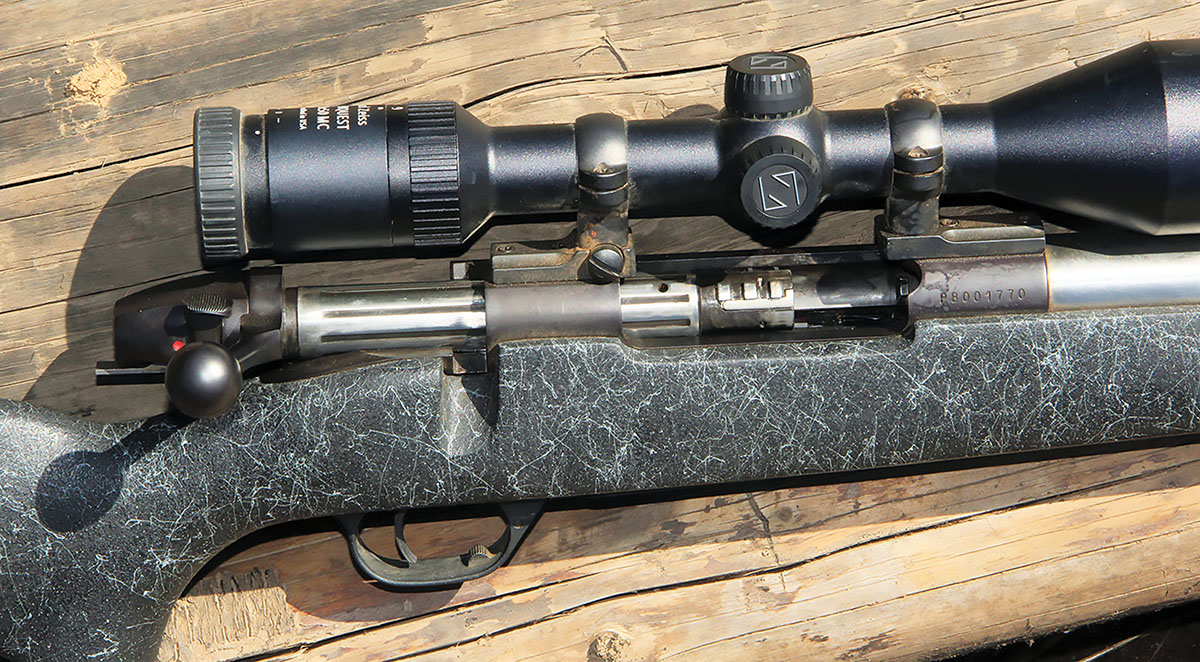
Weatherby uses a distinctive fluted, nine-lug bolt, which cycled smoothly, despite its obvious lack of regular cleaning.
Interestingly, the test rifle had shown a preference for Weatherby factory 117-grain roundnose loads. Such bullets are perhaps ideal for Texas corn-feeder whitetails, but for Rocky Mountain bull elk, not so much (or even long-range pronghorn, as we discovered on that rifle’s inaugural hunt). Auditioning various spire-point factory loads had apparently resulted in conspicuously larger 100-yard groups. I assured Kelsey handloading was the solution, and that not only would we find something to match the 1-MOA accuracy of the roundnose load, but a bullet that would prove reliable on tenacious bull elk.
The 257 Weatherby Magnum is by far our fastest .257-caliber cartridge, bettering even wildcat quarter-bores. Many are quick to deem the 257 Weatherby Magnum marginal for elk, but there was a time when a certain cadre of hunters considered the ultra-fast round a death ray. Wally Taber, whose annual lectures I anxiously attended as a teen, used the Weatherby round to kill tough zebra and wildebeest and even African Cape buffalo. I wouldn’t go so far as to recommend the 257 Weatherby Magnum for Mbogo, but with today’s premium bullets, zebra and wildebeest are well within the cartridge’s capabilities – as are North American bull elk.

The test rifle was Weatherby’s Mark V AccuMark with a 26-inch barrel and 1:10 twist rate, with a Zeiss Conquest 3-9x 50mm MC scope. The rifle has been used hard and put away wet since it was purchased more than 20 years ago.
Though an outwardly modern cartridge, the 257 Weatherby Magnum was introduced by Roy Weatherby in 1944. Roy created the case by shortening the rimless/belted 375 H&H Magnum, necking it to 257 caliber and giving it his trademark double-radius shoulder. The Weatherby round also includes a long case neck for excellent bullet alignment and ample bullet tension, without intruding into powder space while loading long-for-caliber bullets. The Weatherby holds about 86.3 grains of water, verses 68.6 grains for the 25-06 Remington, with a Sporting Arms and Ammunition Manufacturers’ Institute (SAAMI) maximum average pressure (MAP) of 62,500 psi, verses 63,000 psi for the 25-06. The former sends 100-grain bullets at velocities of up to 3,550 fps, compared to 3,300 fps for the 25-06; pushing 120s at up to 3,300 fps to the ‘06’s 3,150 fps.
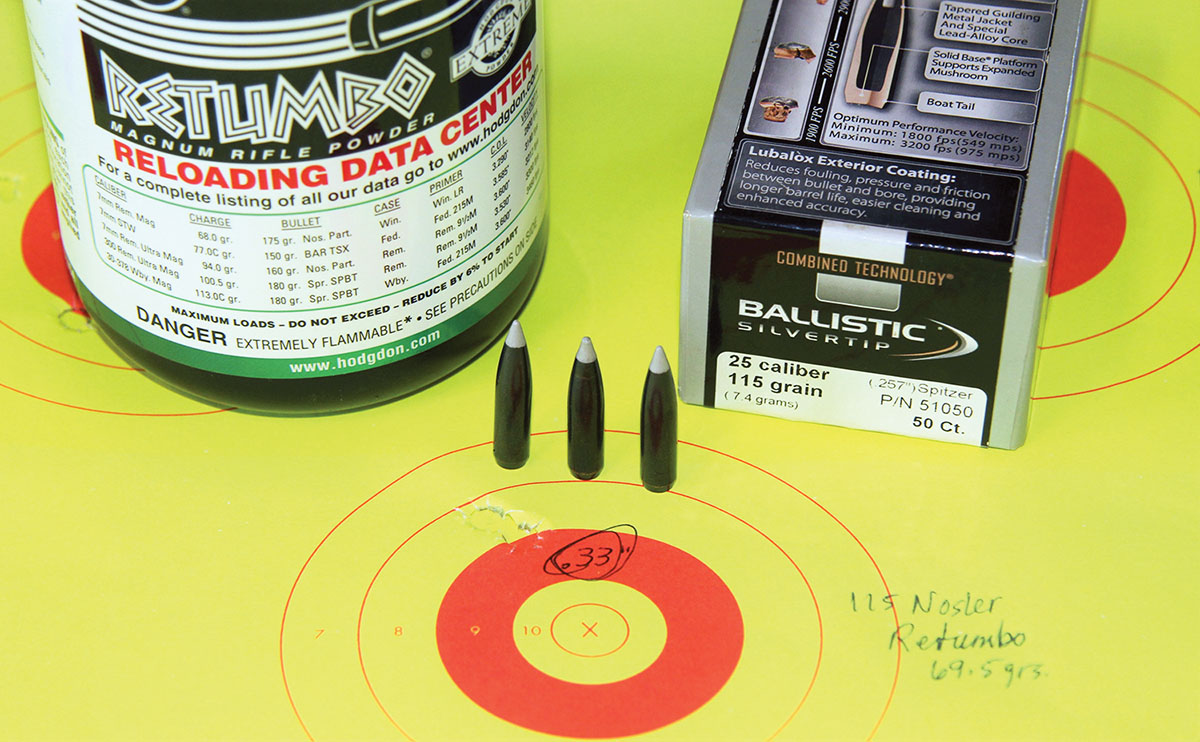
Nosler’s 115-grain Ballistic Silvertip and 69.5 grains of Hodgdon Retumbo produced the best group of the entire test – .33 inch at 3,245 fps. This would make a reliable elk load.
The 257 Weatherby Magnum, with its decidedly overbore dynamics, thrives on slow-burning powders in the Hodgdon 1000, Alliant Reloder 25 and IMR-7828ssc class. The versatile round generally relinquishes its best accuracy and minimum extreme velocity spreads while using loads approaching maximum.
Better accuracy will also be realized when cases are sized to headspace off the shoulder instead of the belt, meaning a backed-off full-length die or neck sizing only after initial fireforming. This can also minimize stretching just forward of the belt and help prolong case life – though brass should be inspected closely for impending case separation after four to six firings with maximum loads. The high pressures of the Weatherby round generally result in accelerated case stretching, trimming to 2.549 inches and periodic neck annealing is recommended. All that freebore makes it difficult to seat bullets too close to the lands (though magazine space can factor), making precision alignment and minimal bullet runout imperative to top-notch accuracy. The Weatherby’s extreme performance means accuracy lies in the smallest details, seating depth large among these.
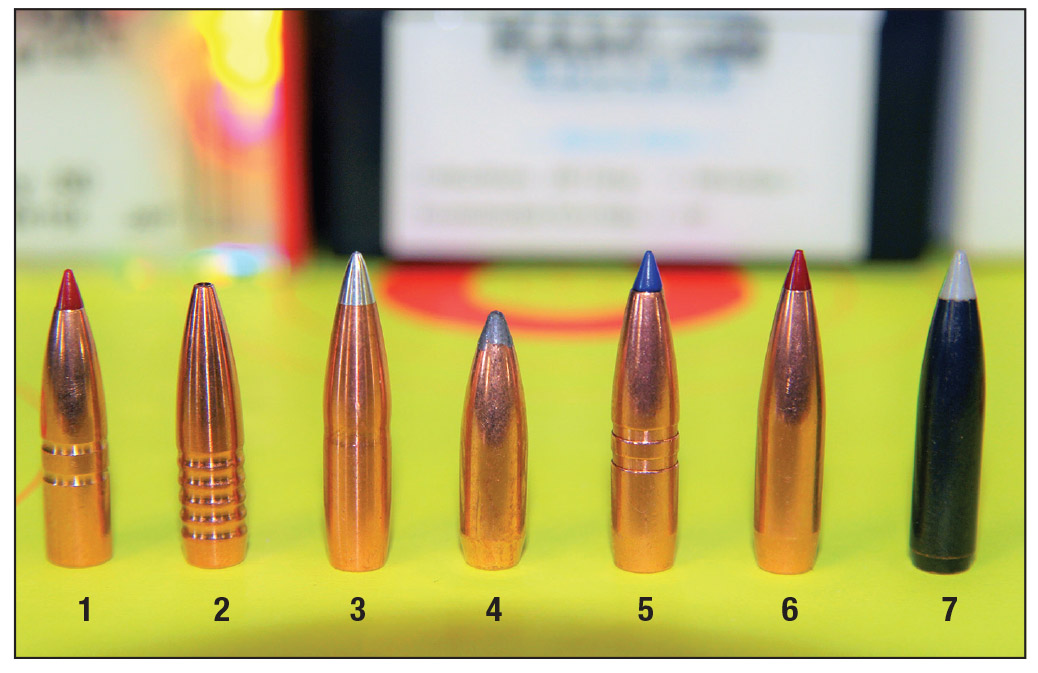
Bullets used for testing included: (1) Hornady’s 90-grain CX, (2) Hammer Bullets’ 92-grain Hammer Hunter, (3) Badlands Precision 95-grain Bulldozer2, (4) Speer’s 100-grain Boattail Soft Point, (5) Barnes’ 101-grain LRX BT, (6) Hornady’s 110-grain ELD-X and (7) Nosler’s 115-grain Ballistic Silvertip.
The test rifle was Weatherby’s Mark V AccuMark with a fluted sporter-weight, stainless steel barrel measuring 26 inches long (the 257 Weatherby Magnum gains about 40 fps per inch of barrel length), including a 1:10 rifling twist and measuring .71-inch in diameter at the muzzle. The fluted bolt included Weatherby’s distinctive nine-lug configuration and cycled smoothly. The safety was a toggle type and locked the bolt when engaged. The laid-up synthetic stock was comfortable, and combined with the soft recoil pad, made the magnum cartridge surprisingly pleasant to shoot off a bench. The trigger broke at 3.75 pounds with some small amount of creep before the break. The rifle was topped with a Carl Zeiss Conquest 3-9x 50mm MC scope set in Leupold STD rings and bases. The rifle’s finished weight was 10.21 pounds.
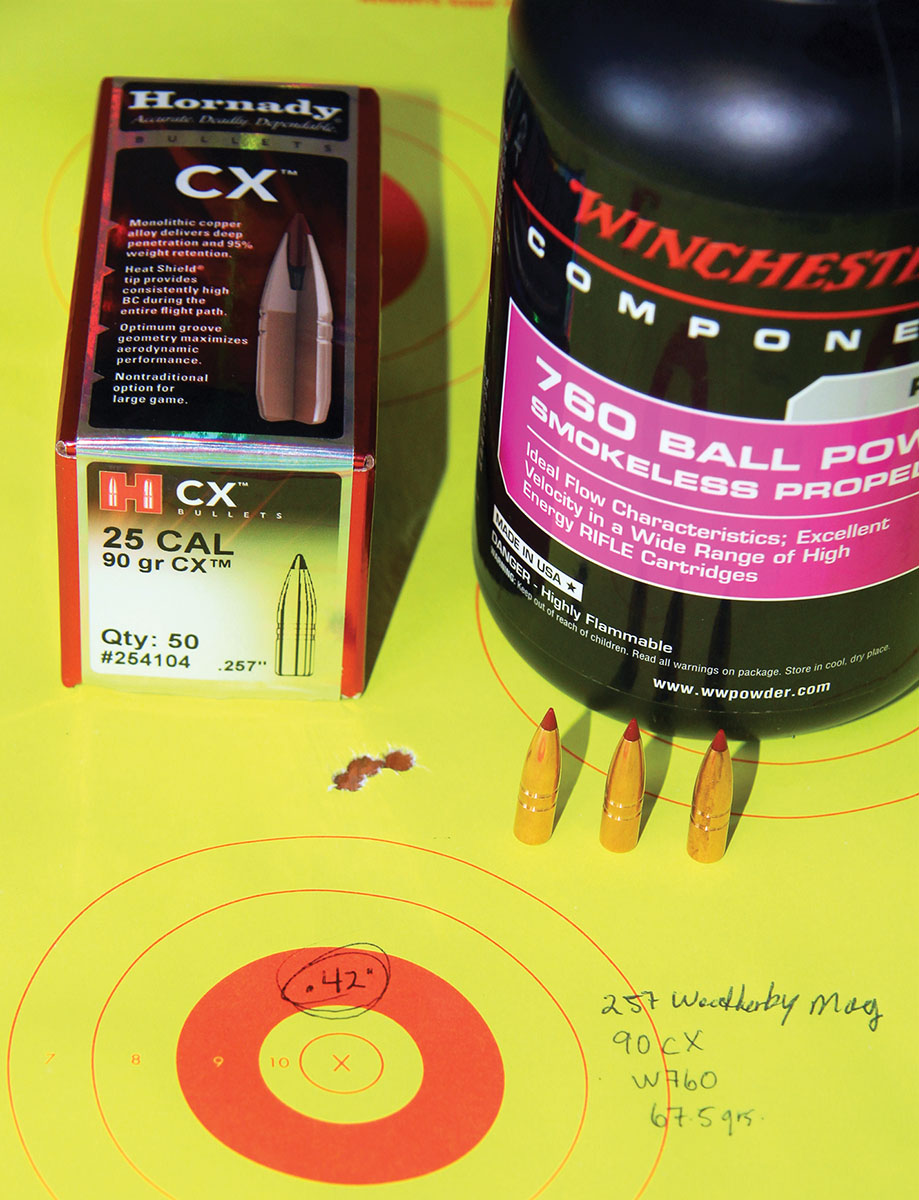
The best group assembled with Hornady’s 90-grain CX involved 67.5 grains of Winchester 760, that group measured .42 inch and was sent at a sizzling 3,910 fps.
Bullets were selected from stock on hand for my 25-06 Remington. Kelsey preferred the environmentally friendly aspects of monolithic copper designs, so they were heavily represented in this test. Weatherby Ammunition Select Unprimed Brass with CCI No. 250 Magnum Large Rifle primers installed were used for all loads. As testing commenced, the rifle’s 1:10 twist revealed some disappointing stabilization issues. The 257 Weatherby Magnum’s velocity also proved a bit robust for at least one bullet.
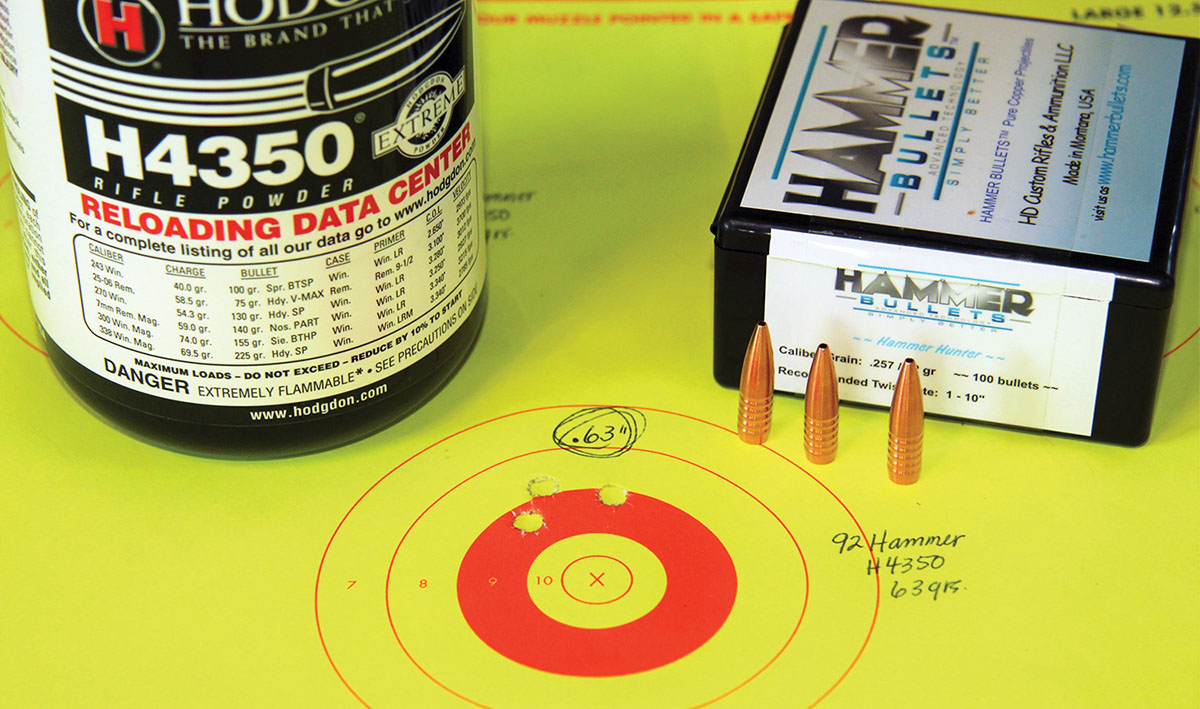
Hammer Bullets’ 92-grain Hammer Hunter did best with 63 grains of Hodgdon H-4350, printing into .63 inch at 3,574 fps.
Hornady’s 90-grain CX is a mono-copper bullet with a red Heat Shield tip and flat base that created a .273 G1 ballistic coefficient (BC). The CX was added after some longer boat-tail monolithic options performed poorly, pairing it with Hodgdon H-4831, Alliant Reloder 17 and Winchester 760. Combined, these loads created a 1.05-inch group average, skewed heavily by a single bad group. H-4831 produced some great results, including a .60-inch group at 3,639 fps using 68.5 grains of powder, and .71 inch at 3,722 fps with a maximum load of 70.5 grains. Reloder 17’s best showing was .85 inch, with 65.5 grains of powder pushing things to a smoking 3,837 fps. Winchester 760 produced both the largest and smallest groups with this bullet. The most interesting, of course, was one of the smallest of the test, a .42-inch group produced with a maximum load of 67.5 grains sent at a sizzling 3,910 fps!
Hammer Bullets’ 92-grain Hammer Hunter is another monolithic copper bullet, designed to shed its nose petals for maximum devastation, the solid base then pushing deep. The bullet is compatible with a 1:10 rifling twist. The Hammer Hunter includes pressure relief grooves to minimize fouling. While 90- and 92-grain bullets may seem light for our intended goals, Hornady’s former ballistician guru, Dave Emary, said adding 20-25 percent to the weight of monolithic bullets equates to the approximate performance potential of conventional lead-core bullets. A long ogive and sleek boat-tail gives this lead-free bullet a .165 G7 BC. It was paired with Hodgdon H-4350, Vihtavuori N165, and Alliant Reloder 22, all groups averaging just 1.03 inches. H-4350 hit a maximum velocity of 3,574 fps with 63 grains of powder while producing a .63-inch group. N165 also waited until hitting maximum velocities to print a sub-1-MOA group of .98 inch at 3,637 fps with 70.5 grains of powder. Approach that maximum load with care, as it was pretty spicy. Reloder 26 did best with 70 grains of powder printing .69 inch at 3,723 fps, a great combination of speed and accuracy.
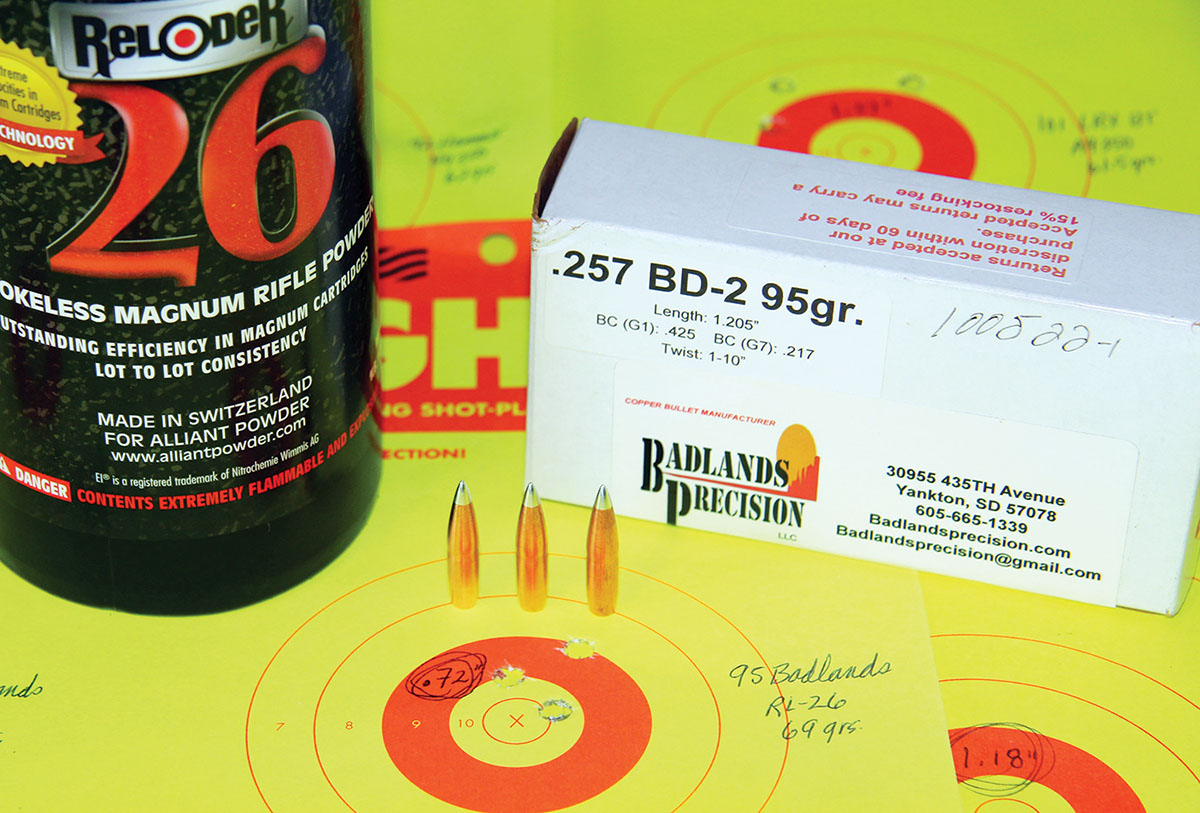
The 95-grain Bulldozer2 by Badlands Precision produced this .72-inch group at 3,642 fps when paired with 69 grains of Alliant Reloder 26.
Badlands Bullets’ 95-grain Bulldozer-2 is another copper bullet with a very sleek profile made from a long boat-tail and a milled-aluminum tip. This created an excellent .425 G1 BC – ideal for longer shots and bucking side winds. IMR-7828ssc, Ramshot LRT, and Alliant Reloder 26 were paired with this bullet, providing a group average of 1.41 inches. This larger group average I attribute to the bullet riding the stabilization edge at the 3,200 foot altitude where testing was conducted (it would no doubt improve at the 10,000-plus foot altitude of Kelsey’s property). IMR-7828ssc managed just 1.21 inches using 66.5 grains of powder and pushed to 3,541 fps. Ramshot LRT did best with a maximum load of 79.5 grains sent at 3,622 fps. That group measured 1.04 inches. The best group with this bullet measured .72 inch at 3,643, using 69 grains of Reloder 26.
Speer’s 100-grain Boat Tail Soft Point was added after other test bullets failed to stabilize, thinking it might make a great pronghorn option. Alliant Reloder 25, IMR-7828ssc and Hodgdon Hybrid 100V were tried, with all assembled groups averaging a horrific 2.02 inches. My educated guess tells me the bullet was a bit thin-skinned for the Weatherby’s extreme velocity – that theory is based on the fact all the best groups were produced by the lightest loads. As loaded as this bullet was an utter disappointment, though throttling back velocity would likely result in better outcomes.
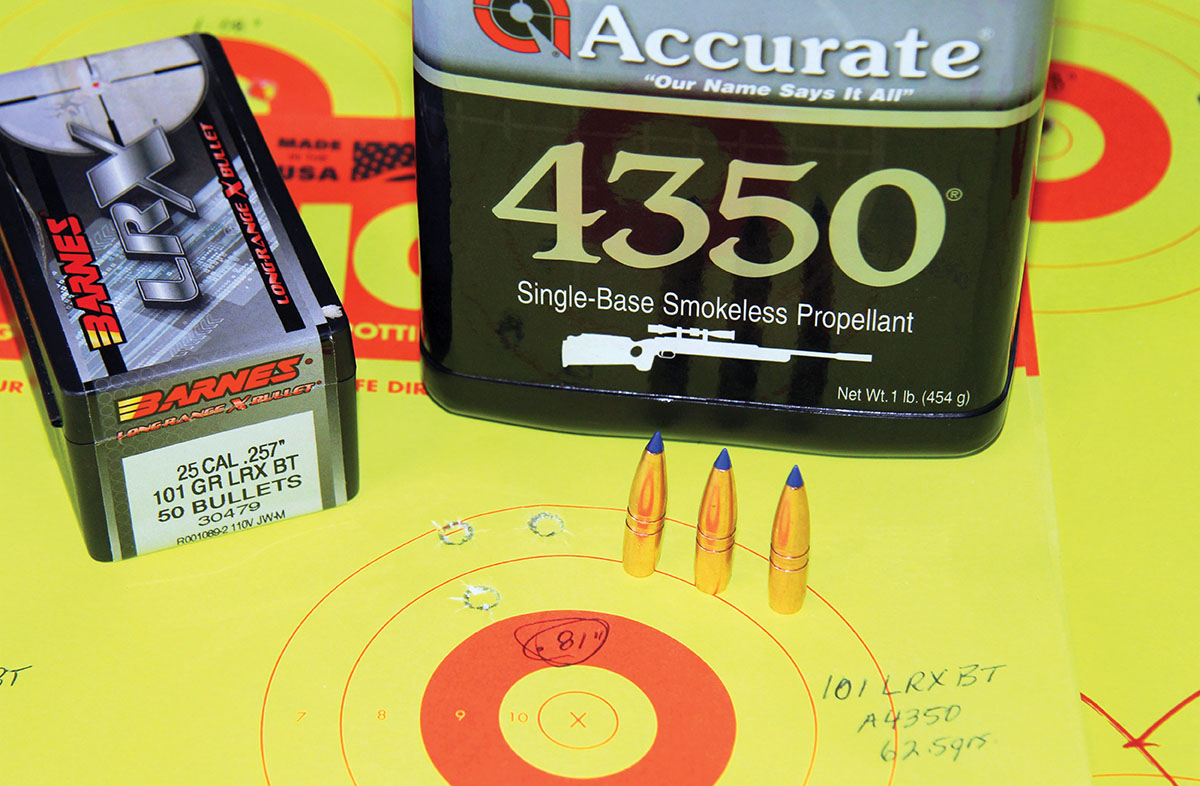
Barnes’ 101-grain LRX BT struggled a bit from the 257 Weatherby Magnum’s 1:10 rifling twist, the best group was .81 inch at 3,379 fps and was produced by 62.5 grains of Accurate 4350.
The Barnes 101-grain LRX BT (Long Range X, Boat Tail) included an excellent-for-257 caliber G1 BC of .400, created by a blue polymer tip and sleek boat-tail profile. Its mono-copper construction and relatively high sectional density should help penetration on large game such as bull elk, though I had some small concerns for stabilization with the 1:10 rifling twist. While it would undoubtedly stabilize in the thinner atmosphere of Kelsey’s property, it might also be used to tag Texas whitetails closer to sea level where the test rifle’s slow rifling twist would likely be found lacking. It was matched with Ramshot LRT, Hodgdon H-1000 and Accurate A-4350. These powders combined for a dismal 2.11-inch group average; the bullet obviously exceeding the twist rate’s stabilization limit at 3,200 feet above sea level, in addition to the fact we seemed to have scored a box of defective bullets, as one out of four of the polymer tips seemed to be installed crooked. A-4350 did manage to produce one good group of .81 inch at 3,379 fps with a maximum load of 62.5 grains of powder.
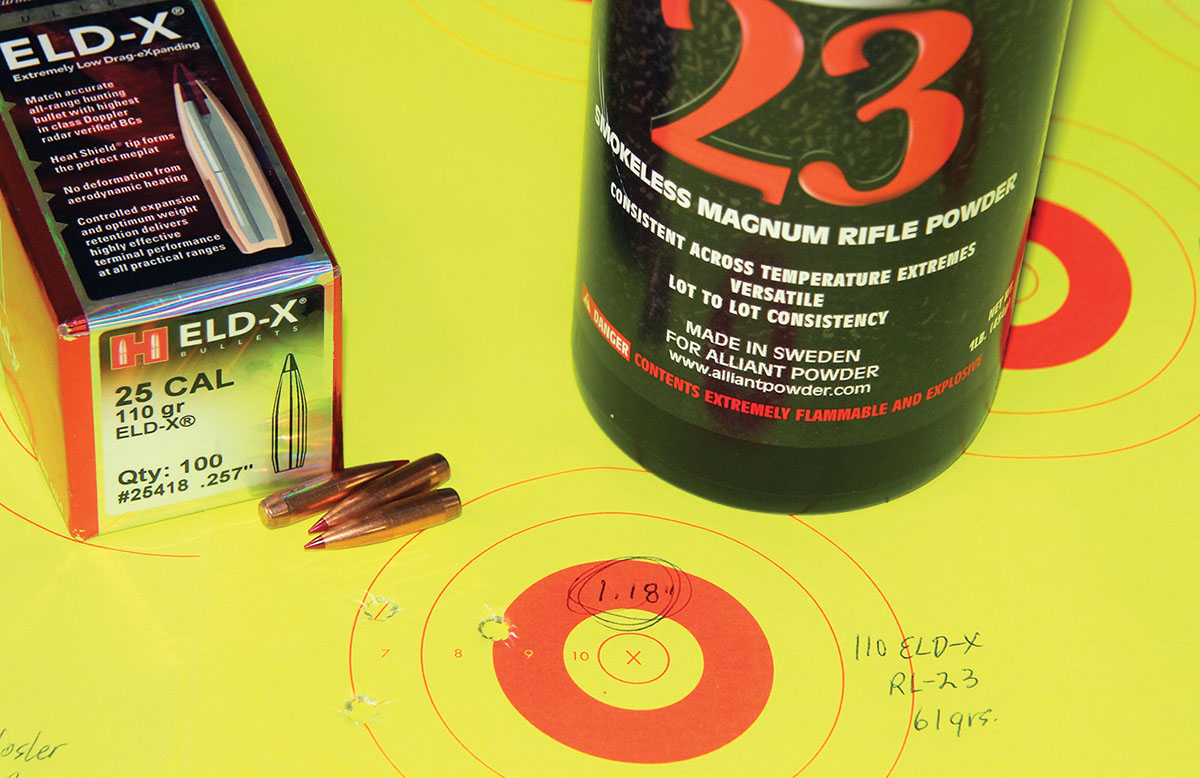
Hornady’s 110-grain ELD-X taxed the 257 Weatherby’s 1:10 twist rate, its best results included 61 grains of Alliant Reloder 23 and a velocity of 3,188 fps. The group measured 1.18 inches.
Hornady’s 110-grain ELD-X (Extremely Low Drag – eXpanding) provided a superior ballistic coefficient (.465 G1 BC) and a Heat Shield Tip impervious to aerodynamic heating on longer shots. An AMP jacket, sleek secant ogive and boat-tail design provide match-grade accuracy at longer ranges. A thick jacket shank and InterLock ring ensure 50 to 60 percent weight retention at even high velocities/shorter ranges. The ELD-X was fueled by Alliant Reloder 23, Ramshot Magnum, and Vihtavuori N560 and provided a disappointing 2.33-inch overall group average. This is when bullet stabilization really began to factor – odd only in that my 25-06 Remington with supposedly identical rifling twist shoots this bullet well… N560 does not need discussion, and Magnum barely makes the cut with a 1.36-inch group best. Reloder 23 did manage 1.23- and 1.18-inch groups at 3,144 and 3,188 fps, respectively, so some potential does exist for this bullet from this rifle, especially at higher elevations.
The Berger 115-grain VLD (Very Low Drag) Hunting included in initial testing started so badly that it was quickly scrapped after the first load ladder. It produced patterns instead of groups, showing a decided lack of stabilization, which again was odd, as my 25-06 gets along well with these bullets.
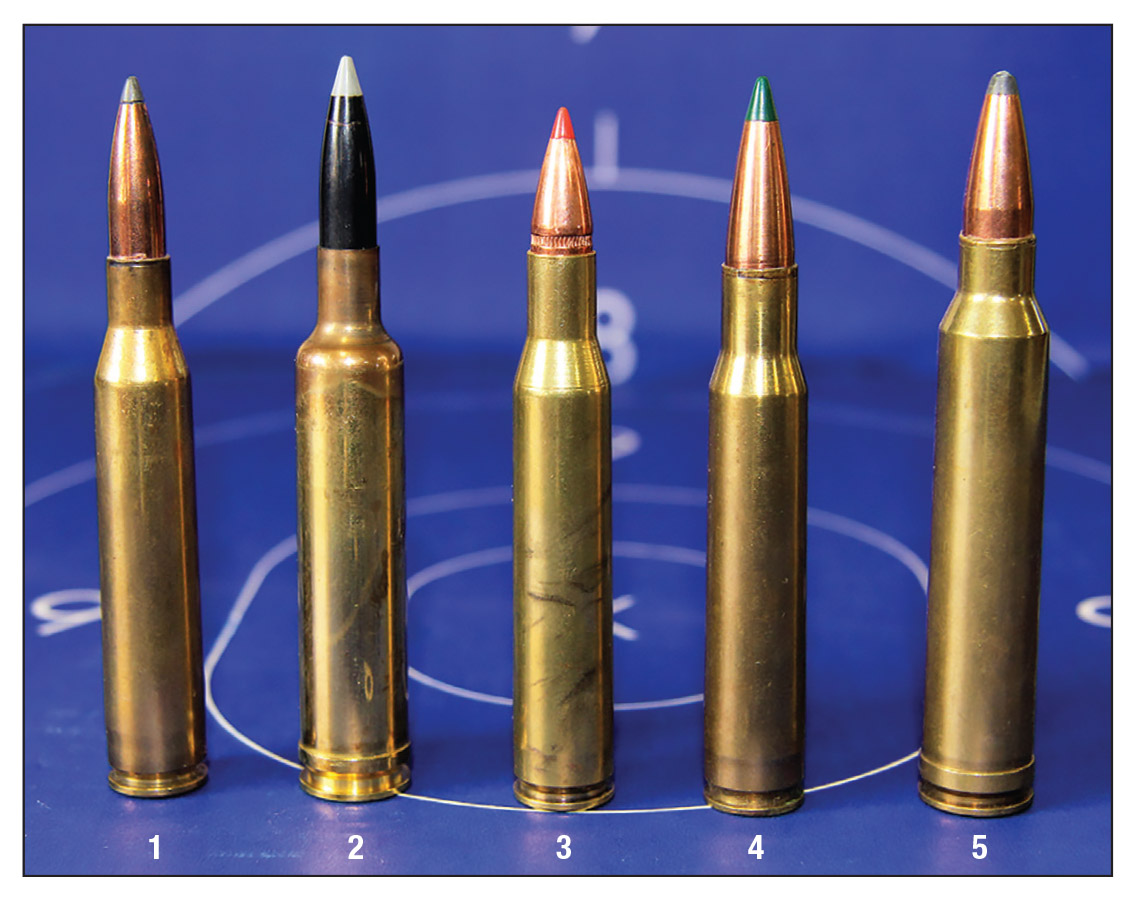
Shown for comparison: (1) 25-06 Remington, (2) 257 Weatherby Magnum, (3) 270 Winchester, (4) 30-06 Springfield and (5) 300 Winchester Magnum.
From my 25-06, I’ve become especially partial to Nosler’s 115-grain Ballistic Silvertip. They assemble one-hole groups from my rifle and exhibit predictable expansion via a tapered jacket, special lead-alloy core and thick-walled jacket base. The white polymer tip and boat-tail provided a .453 G1 BC and the black oxide Lubalox coating reduced barrel fouling without depositing residue. Hodgdon Retumbo, Accurate MagPro, and Reloder 25 really turned things around on the heavy end, providing a 1.35-inch group average. MagPro managed only 1.33 inches at 3,348 fps with 67.5 grains of powder. Reloder 25 did much better, producing a .50-inch group at a quick 3,577 fps using 71 grains of powder. The best group with this bullet, and the entire test, resulted from a 69.5-grain maximum load of Retumbo, that group measured .33 inch at 3,245 fps. Despite that group, I’d go with the half-inch 3,577 fps combo for elk.
The 257 Weatherby Magnum cartridge, and this rifle in particular, certainly provided some hair-pulling frustration. Some work invested to open the barrel channel and mitigate barrel contact after testing commenced will no doubt solve some of this rifle’s issues, but the cartridge itself, with all that velocity, makes this an extremely fussy round.











.jpg)
.jpg)


